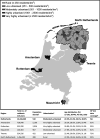Who is providing HIV diagnostic testing? Comparing HIV testing by general practitioners and sexual health centres in five regions in the Netherlands, 2011-2018
- PMID: 34315804
- PMCID: PMC9120378
- DOI: 10.1136/sextrans-2021-055109
Who is providing HIV diagnostic testing? Comparing HIV testing by general practitioners and sexual health centres in five regions in the Netherlands, 2011-2018
Abstract
Objectives: General practitioners (GPs) and sexual health centres (SHCs) are the main providers of HIV testing and diagnose two-thirds of HIV infections in the Netherlands. We compared regional HIV testing and positivity by GPs versus SHCs to gain insight into strategies to improve HIV testing, to enable timely detection of HIV infections.
Methods: Laboratory data (2011-2018) on HIV testing by GPs and SHCs in five Dutch regions with varying levels of urbanisation were evaluated. Regional HIV testing rates per 10 000 residents ≥15 years (mean over period and annual) were compared between providers using negative binomial generalised additive models and additionally stratified by sex and age (15-29 years, 30-44 years, 45-59 years, ≥60 years). χ2 tests were used to compare positivity percentage between the two groups of providers.
Results: In the study period, 505 167 HIV tests (GP 36%, SHC 64%) were performed. The highest HIV testing rates were observed in highly urbanised regions, with large regional variations. The HIV testing rates ranged from 28 to 178 per 10 000 residents by GPs and from 30 to 378 per 10 000 by SHCs. Testing rates by GPs were lower than by SHCs in three regions and comparable in two. In all regions, men were tested less by GPs than by SHCs; for women, this varied by region. Among those aged 15-29 years old, GPs' testing rates were lower than SHCs', while this was reversed in older age categories in four out of five regions. The overall mean HIV positivity was 0.4%. In contrast to other regions, positivity in Amsterdam was significantly higher among individuals tested by GPs than by SHCs.
Conclusions: This retrospective observational study shows that besides SHCs, who perform opt-out testing for key groups, GPs play a prominent role in HIV testing, especially in non-key populations, such as women and older individuals. Large regional variation exists, requiring region-specific interventions to improve GPs' HIV testing practices.
Keywords: HIV; epidemiology; general practice; primary health care; sexual health.
© Author(s) (or their employer(s)) 2022. Re-use permitted under CC BY-NC. No commercial re-use. See rights and permissions. Published by BMJ.
Conflict of interest statement
Competing interests: None declared.
Figures


References
-
- van Sighem AI, Wit F, Boyd A. et al. . Human Immunodeficiency Virus (HIV) Infection in the Netherlands. Amsterdam: Stichting HIV Monitoring, 2019.
-
- Op de Coul ELM, Joore IK, van Sighem A, et al. . Hiv-bestrijding begint Met GIS-werk. Ned Tijdschr Geneeskd 2017;161. - PubMed
-
- Staritsky LE, Van Aar F, Visser M, et al. . Sexually transmitted infections in the Netherlands in 2019. Bilthoven: National Institute for Public Helath and the Environment (RIVM), 2020.
-
- Heijnen A, Hermanussen R, Verlee L, et al. . Hiv - verdieping naast NHG-Standaard 'Het Soa-Consult'. Amsterdam: Huisarts Advies Groep Seksuele Gezondheid, 2019.
-
- LCI-RIVM . Seksuele gezondheid, het consult - 6. Testbeleid Bilthoven: RIVM, 2019. https://lci.rivm.nl/draaiboeken/consult-seksuele-gezondheid
Publication types
MeSH terms
LinkOut - more resources
Full Text Sources
Medical
Miscellaneous
